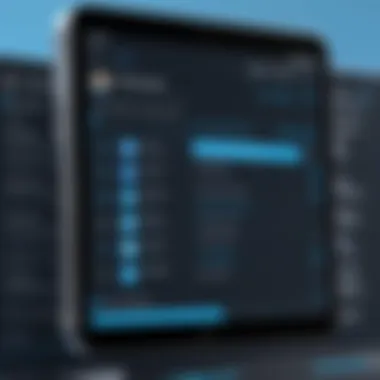Exploring the Powerful Features of Twitterdeck


Intro
The landscape of social media management continuously evolves, and tools like Twitterdeck play a crucial role in shaping this dynamic environment. Twitterdeck, a robust application designed for Twitter users, enhances real-time engagement and interaction. Its comprehensive features enable various users, from marketers to developers and casual users, to take full advantage of Twitter's potential. Understanding how to navigate and leverage Twitterdeck effectively can greatly enhance social media strategies and provide a competitive edge.
Software Overview
Purpose and function of the software
Twitterdeck aims to streamline the Twitter experience for users, allowing for better organization and management of multiple Twitter accounts. This tool caters to the needs of both individual users as well as businesses, ensuring that they can keep track of conversations, notifications, and posts in a user-friendly interface. By aggregating tweets and interactions, Twitterdeck transforms the chaotic nature of Twitter into a manageable and efficient experience.
Key features and benefits
Twitterdeck is rich with features that enhance its functionality and user experience:
- Multi-Account Management: Users can manage multiple Twitter accounts simultaneously, making it ideal for agencies and brands with a presence on various platforms.
- Customizable Columns: Users can create customized columns to monitor specific lists, hashtags, and searches, ensuring focused engagement.
- Real-Time Updates: With live updates, users receive instant notifications, keeping them informed of developments as they happen.
- Scheduled Tweets: The ability to schedule tweets allows for strategic planning, ensuring that messages reach audiences at optimal times.
- Search and Filter Functions: Users can search for particular tweets, hashtags, or mentions, making it easier to track relevant discussions and topics.
These features not only provide utility but also enhance the overall effectiveness of social media campaigns where timely and relevant responses are key.
Installation and Setup
System requirements
Before diving into the installation process, it is essential to review the system requirements for Twitterdeck:
- A modern web browser (Chrome, Firefox, Safari)
- Stable internet connection
- Twitter account for authentication
Installation process
As Twitterdeck is a web-based application, the installation process is straightforward. Here are the steps to get started:
- Open your preferred web browser.
- Navigate to Twitterdeck.
- Sign in using your Twitter account credentials.
- Customize your dashboard by adding or removing columns based on your preferences.
Once set up, users can begin to explore the platform's full functionality, maximizing their Twitter interaction.
Culmination
In summary, Twitterdeck serves as an indispensable tool for anyone looking to optimize their Twitter presence. Whether for professional purposes or personal use, understanding its features and setup process is the first step toward effective social media management. As users delve deeper into the functionalities, they will find tailored solutions that enhance their overall experience. By staying informed about the tools available, individuals can ensure their integration into the fast-paced world of social media leads to meaningful engagement and results.
Preamble to Twitterdeck
Twitterdeck represents a significant evolution in how users interact with the Twitter platform. As social media continues to dominate communication, accessing and managing multiple accounts or interactions efficiently has become essential. This section aims to introduce Twitterdeck, highlight its relevance, and discuss its various facets.
Overview of Twitterdeck
Twitterdeck is a web-based application that facilitates users in managing their Twitter accounts in a more organized manner. It provides a streamlined interface that allows users to view and engage with multiple Twitter feeds simultaneously. Users can customize their experience by creating different columns for different aspects of their Twitter engagement, such as mentions, direct messages, and specific lists. This customization is vital for professionals like digital marketers, customer service personnel, and anyone handling a significant volume of Twitter interactions. By centralizing pertinent information, Twitterdeck enhances productivity and encourages meaningful engagement.
Purpose and Development
The primary purpose of Twitterdeck is to optimize user engagement on Twitter. Developed to help individuals and organizations keep track of interactions in real-time, it streamlines tasks like tweeting, retweeting, and responding to messages. The platform supports a varied user base, from casual users wanting to monitor tweets from their friends to businesses managing customer interactions. Over the years, Twitterdeck has witnessed several updates, often adapting to the changing landscape of social media and user expectations, thus reinforcing its place as a premier tool in social media management. By combining these functionalities, Twitterdeck enhances users' capacity to adapt their strategies effectively in a fast-paced environment.
Key Features of Twitterdeck


The importance of key features in Twitterdeck lies in their ability to streamline social media management for users. Understanding these functionalities helps users maximize the platform's potential. Each feature plays a significant role in enhancing productivity, improving engagement, and facilitating effective communication strategies. Here, we delve into essential aspects of Twitterdeck, providing a comprehensive guide.
Dashboard Customization
One of Twitterdeck's standout features is its dashboard customization. Users can select and arrange columns that display specific information relevant to their needs. This flexibility enables users to focus on important content and metrics, thereby optimizing their workflow. Customizing the dashboard allows digital marketers to track campaigns, while influencers can monitor engagement on their tweets. By setting up the dashboard according to individual preferences, users gain efficiency and clarity in their operations.
Multiple Account Management
Managing several accounts can be tedious. However, Twitterdeck solves this with its efficient multiple account management. Users can easily switch between accounts without logging in and out. This feature is particularly beneficial for social media managers and agencies who handle various client accounts. It saves time and reduces the chances of posting on the wrong account. The multi-account functionality allows for a unified view of conversations, tweets, and interactions across different profiles.
Real-Time Updates
In today’s fast-paced digital environment, staying updated is crucial. Twitterdeck offers real-time updates, ensuring that users receive the latest tweets and notifications as they happen. The immediacy of information allows marketers to react quickly to trends, while businesses can track customer feedback in real time. Instant updates are vital for not just engagement but also for responding promptly to potential issues or opportunities within the Twitter sphere.
Scheduling Tweets
Financial constraints and time limitations often impair effective social media strategies. Twitterdeck alleviates this issue with its tweet scheduling feature. Users can compose tweets and schedule them for future posting. This creates an opportunity to maintain a consistent online presence without needing to be actively engaged at all times. Moreover, scheduling helps in targeting specific demographics at optimal times, thereby maximizing reach and engagement.
Engagement Tools
Twitterdeck also offers various engagement tools that aid in the user interaction process. These tools enable users to manage conversations, track mentions, and respond to inquiries or comments efficiently. By harnessing these capabilities, social media professionals can enhance their engagement strategy, build stronger connections with followers, and cultivate a loyal audience.
By utilizing Twitterdeck's engagement tools, users can significantly increase their responsiveness and visibility on the platform.
Benefits of Using Twitterdeck
The benefits of using Twitterdeck cannot be overstated, especially for users engaged in social media management. This tool enhances the overall experience for a variety of professionals, from marketers to software developers. By providing multiple functionalities in one platform, Twitterdeck serves to streamline workflow and optimize communication strategies. This section will elaborately explore specific benefits such as enhanced productivity, improved user experience, and insightful analytics.
Enhanced Productivity
One significant advantage of Twitterdeck is its capacity to increase productivity among users. The platform allows for customizable dashboards, enabling users to view their feeds and notifications in real-time. This means that updates from multiple accounts or specific hashtags can be monitored simultaneously.
The ability to schedule tweets is also a vital feature. Users can plan their content ahead of time, ensuring consistent posting without the need for constant manual updates. This can lead to better audience engagement, as well as a more organized content strategy.
Additionally, by consolidating various functions in one interface, Twitterdeck minimizes the time spent switching between different apps or platforms. Thus, users can focus on content creation and interaction rather than having to navigate multiple sources.
Improved User Experience
Twitterdeck provides a user-friendly interface that contributes to a more satisfying experience. For many, the traditional Twitter interface can seem cluttered and overwhelming. Twitterdeck simplifies this by offering a strategic layout where users can prioritize what they see.
The drag-and-drop functionality allows users to organize their columns according to their preferences. This customization helps to enhance the interaction with tweets, making it easier to engage with followers effectively. Moreover, the consistent layout promotes familiarity, easing the transition for new users.
For those new to social media management, having an intuitive platform can significantly reduce anxiety and enhance confidence. The help resources and community support available on forums, such as reddit.com, also foster a learning environment for users.
Insightful Analytics
Another compelling benefit of Twitterdeck is its analytics features. Users can access information that provides insight into engagement metrics, follower growth, and the performance of tweets. This data is crucial for developing informed marketing strategies and maximizing content effectiveness.
By analyzing which tweets gain the most traction, users can better tailor their future content to meet the needs of their audience. This insight helps not only in content planning but also in adjusting strategies to improve return on investment (ROI).
Additionally, Twitterdeck's integration with third-party applications can enhance further analytical capabilities. Users can import data into tools like Google Analytics for more comprehensive data visualization and reporting. This synergy between platforms helps reinforce users' knowledge about their audience and enhances decision-making processes.
"The analytics feature empowers users to optimize their content strategy through data-driven decision making."


In summary, the benefits of Twitterdeck encompass improved productivity, a better user experience, and insightful analytics. These functions play a fundamental role in making Twitterdeck an essential tool for effective social media management.
Challenges and Limitations
Understanding the challenges and limitations of Twitterdeck is crucial for users to effectively navigate its platform. Recognizing these aspects can aid users in optimizing their experience and mitigating potential issues. Each limitation can impact workflows, effectiveness, and overall satisfaction with the tool. By identifying specific obstacles, users can adopt proactive measures to counteract them.
Technical Glitches
Technical glitches are a common concern for any software platform, and Twitterdeck is no exception. Users sometimes face issues like slow loading times, unresponsive features, or temporary outages. These disruptions can lead to frustration, especially for users managing multiple accounts or requiring timely updates.
Users should be aware that technical glitches may arise due to high traffic or maintenance modes. Understanding this can help in adjusting expectations, particularly during peak usage times. Regular updates and support from Twitter are aimed at reducing these incidents. However, users should consider having a backup method for monitoring their Twitter activity during prolonged outages to maintain their engagement levels.
Learning Curve for New Users
The learning curve associated with Twitterdeck can be a barrier for new users. The platform offers a range of features that may feel overwhelming initially. Understanding how to customize dashboards, manage multiple accounts, and utilize analytics efficiently takes time and practice.
New users are encouraged to explore Twitterdeck's tutorials and help resources. These can provide structured guidance on using the tool optimally. Additionally, joining community forums such as those on Reddit can offer valuable support from experienced users sharing their tips. Training sessions or workshops, whether formal or informal, can also facilitate a smoother onboarding process.
Dependence on Twitter Policies
Another significant limitation is the tool's dependence on Twitter's policies. Changes in Twitter's API or terms of service can directly influence how Twitterdeck functions. This dependence creates uncertainty for users, particularly those leveraging the tool for marketing or analytics. Any major policy shifts can alter the effectiveness of certain features, impacting user satisfaction and strategy.
Users should remain informed about Twitter's updates and announcements. Subscribing to official channels or following relevant news articles can provide pertinent information on any changes. In this way, users can adapt their strategies accordingly and remain effective in their use of Twitterdeck. This awareness is critical for maintaining a proactive stance in social media management.
Use Cases for Twitterdeck
Twitterdeck serves as a vital instrument for a myriad of users in different sectors. Understanding its use cases helps to grasp its essential role in streamlining social media management. Each user group can leverage its functionalities to optimize their workflow and improve their online presence. This section highlights practical examples that demonstrate how diverse users can benefit from Twitterdeck’s robust features.
Best Practices for Twitterdeck Users
Using Twitterdeck effectively requires a clear understanding of best practices that enhance user experience and overall productivity. Best practices are essential because they guide users in optimizing resources, leveraging features, and avoiding common pitfalls. This section will focus on two primary best practices: setting up efficient workflows and utilizing analytics for strategy refinement.
Setting Up Efficient Workflows
Establishing an efficient workflow in Twitterdeck is crucial for managing tasks effectively. A well-organized workflow helps users save time and minimize distractions. Here are some strategies to consider:
- Define Your Goals: Clearly outline what you want to achieve. Goals can include increasing engagement, scheduling posts effectively, or monitoring specific topics.
- Create Custom Columns: Twitterdeck allows users to create custom columns tailored to their needs. This can include mentions, direct messages, and hashtags. Having specific columns helps users focus on relevant content and monitor interactions more efficiently.
- Use Keyboard Shortcuts: Familiarize yourself with keyboard shortcuts to navigate Twitterdeck quickly. This can significantly enhance productivity. For instance, pressing "C" creates a new tweet, and "M" opens direct messages.
- Utilize Lists: If you manage multiple accounts or follow various users, create lists to categorize them. This helps in keeping track of important followers or specific topics without cluttering your main feed.
Setting up an efficient workflow requires time and effort, but the benefits are significant. Users can expect improved focus, better time management, and ultimately, more effective communication.
Utilizing Analytics for Strategy Refinement
Analytics play a vital role in evaluating performance on Twitterdeck. By analyzing data, users can refine their strategies and make informed decisions. Here are key points to consider:
- Monitor Key Metrics: Focus on important metrics such as engagement rate, tweet impressions, and follower growth. Tracking these metrics consistently can provide insights into what content resonates with your audience.
- A/B Testing: Utilize Twitterdeck's capabilities to conduct A/B testing on different content types. For example, post similar tweets at different times and compare their performance. This helps in understanding the audience's preferences.
- Understand Audience Behavior: Use analytics to learn more about your audience's behavior. Identify peak interaction times and tailor your posting schedule accordingly.
- Refine Content Strategy: Based on analytics, adjust your content strategy. Experiment with various content formats such as polls, images, or videos. Understanding what works best can lead to more engagement and higher visibility.
"Understanding analytics is not just about numbers; it's about gaining insights to shape your strategy effectively."
Comparison with Other Social Media Management Tools
When analyzing Twitterdeck's functionality, it is crucial to consider how it stands against other social media management tools. Comparing Twitterdeck with established platforms like Hootsuite and Buffer reveals essential insights into its strengths and limitations. Understanding these comparisons benefits users in selecting the most suitable platform for their unique needs and workflows.


Twitterdeck vs. Hootsuite
Hootsuite is one of the most recognized tools in social media management. It offers extensive features for managing various social media accounts. However, when we compare it with Twitterdeck, distinct differences become clear.
- User Interface: Twitterdeck provides a streamlined and focused interface, emphasizing the Twitter experience. Hootsuite's interface includes other platforms, making it more complex for those focused solely on Twitter.
- Real-Time Capabilities: Twitterdeck excels in real-time updates and engagement. Users can monitor multiple timelines, mentions, and hashtags without delay. Hootsuite also provides real-time features, but the experience may feel more cluttered due to the multiple channels.
- Cost: Twitterdeck is free, while Hootsuite has a pricing model that may not suit all budgets. Small teams or individual users may find Twitterdeck a more appealing option.
In summary, Twitterdeck offers a specialized approach tailored for Twitter users, whereas Hootsuite serves a broader spectrum but may add unnecessary complexity.
Twitterdeck vs. Buffer
Buffer is another competitor that many users consider. Buffer focuses on scheduling posts across various social media platforms, providing a simple solution for those looking to manage timing and content delivery. However, its functionality differs in notable ways when set against Twitterdeck.
- Scheduling Flexibility: While Buffer allows bulk scheduling of posts, Twitterdeck provides real-time interactions on tweets. Users can engage with followers immediately and manage their responses dynamically.
- Analytics: Buffer offers detailed analytics for performance tracking across platforms. However, Twitterdeck provides focused analytics that tracks engagement metrics solely for Twitter, which can be more relevant for dedicated Twitter users.
- Interface Appropriateness: Buffer's design is more simplistic and may be easier for newcomers. In contrast, Twitterdeck's interface may intimidate some new users but rewards engagement with its powerful monitoring tools.
Ultimately, the choice between Twitterdeck and Buffer comes down to user priorities. Those who prioritize real-time engagement may prefer Twitterdeck, while those looking for a broader scheduling focus might lean toward Buffer.
By understanding the differences and similarities between these tools, users can make informed decisions that best suit their strategy and goals in social media management.
Future of Twitterdeck
The future of Twitterdeck is significant for multiple reasons, particularly as it relates to the ongoing evolution of social media management tools and their integration with user strategies. With its established role in facilitating efficient management of Twitter accounts, Twitterdeck is positioned to adapt and grow as social media continues to change. The discussion on its future also highlights how Twitterdeck can capitalize on emerging technologies, user feedback, and industry trends to enhance its functionality.
Potential Updates and Enhancements
One of the core aspects of Twitterdeck's future lies in its potential updates and enhancements. As users demand more features, it becomes imperative for Twitterdeck to keep pace. Recent trends suggest that users appreciate greater automation possibilities and improved integration with other platforms.
For instance, integrating with scheduling tools like Google Calendar or task management software such as Trello can enhance productivity. In addition, features that leverage artificial intelligence for trend analysis or tweet optimization can significantly improve user experience.
Moreover, it's vital for Twitterdeck to prioritize mobile optimization. Mobile usage of social media platforms continues to rise. Making its application more responsive will be an essential step in maintaining relevance in a market crowded with competitors like Hootsuite and Buffer.
"Innovations in social media management tools typically mirror advancements in user needs and preferences."
Role in Evolving Social Media Landscape
The role of Twitterdeck in the evolving social media landscape cannot be understated. As consumers increasingly seek personalized content and real-time interactions, tools like Twitterdeck are central to enabling businesses and individuals to respond effectively. This is especially important for marketing strategies, where timely engagement can drive conversion.
With platforms frequently adjusting algorithms that dictate visibility and reach, Twitterdeck’s functionality allows users to react quickly and efficiently. This adaptation is crucial for maintaining audience attention and engagement.
The emergence of new trends such as video content and live engagement calls for Twitterdeck to diversify its offerings. Providing users ability to manage not only tweets but also video posts or live tweets can significantly enhance its utility.
As artificial intelligence continues to change how data is analyzed and interpreted, Twitterdeck may need to embed these advanced analytics directly into its dashboard, allowing users to extract deeper insights on engagement metrics. Updates that harness these technological advancements may further solidify Twitterdeck's position as a leading tool in social media management.
Closure
The conclusion section serves a vital role in encapsulating the journey through Twitterdeck's multifaceted functionalities. It presents an opportunity to reflect on the essential elements discussed throughout the article. These insights not only highlight the significance of Twitterdeck in contemporary social media management but also clarify its practical relevance to developers, marketers, and casual users.
Summarizing Key Insights
This article has provided a comprehensive overview of Twitterdeck’s features and functions. Key insights include:
- User-Centric Design: Twitterdeck’s interface allows for substantial customization, which enhances user engagement and productivity. Users can tailor their dashboards to fit specific needs, resulting in greater control over the information they consume.
- Multi-Account Handling: One of the standout features is the ability to manage multiple Twitter accounts simultaneously. This not only saves time but also streamlines the workflow for businesses and influencers who curate diverse content across various profiles.
- Real-Time Interactions: The platform promotes immediate interactions and updates, ensuring that users remain responsive to follower engagements and trending topics. This immediacy is crucial for digital marketers aiming for timely responses to audience dynamics.
- Insightful Analytics: The analytics tools within Twitterdeck empower users to refine their strategies. This feature enables measurable assessment of tweet performance and audience interaction, providing a data-driven approach to content management.
In summary, Twitterdeck stands out as a pivotal tool for anyone seeking to optimize their Twitter presence, providing efficiency and strategic advantages in social media management.
Final Thoughts on Twitterdeck's Utility
Considering the evolving landscape of social media, Twitterdeck remains a relevant choice for a variety of user demographics. Its integration with the Twitter platform allows for a seamless experience that benefits both novice and experienced users alike. The ability to adapt to user needs and preferences gives it a competitive edge over other social media management tools.
While challenges like technical glitches and policy dependence exist, they do not overshadow the value that Twitterdeck can deliver. Users who leverage its strengths can create effective workflows, driving both personal and professional growth.



